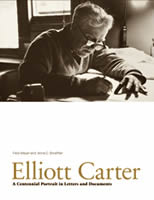Elliott Carter at 100
|
Grant Chu Covell [December 2008.]
Just in time for Elliott Carter’s hundredth on December 11, Boydell teamed with the Paul Sacher Foundation to produce a nifty collection of biography, pictures, letters, essays and reproduced manuscript pages (collected and annotated by Felix Meyer and Anne C. Shreffler). The major phases of Carter’s development are succinctly described alongside his most important works. More detailed analyses necessitate perusing David Schiff’s penetrating The Music of Elliott Carter (1983; new edition 1998), and those with an insatiable desire for every detail must consult the Harmony Book’s categorized pitch collections (2002, edited by Nicholas Hopkins and John Link). Included in this “Centennial Portrait in Letters and Documents” is a recommendation letter for Harvard written by Charles Ives. Carter recalls that the Harvard music department was essentially devoted to training church organists and had nothing to do with modern music. (He graduated with a degree in English literature.) Also appearing, with translations in the appendix where necessary, are exchanges with Boulanger, Boulez, Petrassi, Copland and many others. The birthday boy’s worklist spans from a 1936 Tarantella for men’s chorus with four-hand piano to 2008’s works-in-progress. * * * Up here in New England, several events celebrated the centenary, including two world premieres during December’s first week. I caught two concerts at New England Conservatory (NEC) but missed the Boston Symphony Orchestra unveiling Interventions (2007) for piano and orchestra, with Barenboim, Levine conducting. At NEC on 12/1, a Beethoven String Trio, Op. 9 No. 2, was paired with Carter’s First String Quartet (1950) performed by the Borromeo String Quartet. The First is my favorite Carter opus. I delved into it in high school, and was enthralled by metric modulation, its movements independent of its pauses, and the way varied motives would increase speeds as they reappear. The Library of Congress has posted the manuscript sketches to this quartet and the Sonata for Cello and Piano online. In the Borromeo’s performance, the work was on fire: warming, devastating, unpredictable. I’ve mentioned these fine players in passing before and they were as wonderful as ever. The next evening, 12/2, brought a varied all-Carter evening at NEC: Birthday Flourish (1988) for brass quintet, Woodwind Quintet (1948), Elegy (1946) for string quartet, Cello Sonata (1948), String Quartet No. 2 (1959), ASKO Concerto (1999-2000), and a premiere, Tintinnabulation, for percussion ensemble. Well-prepared conservatory student and preparatory school ensembles provided the quintets, Elegy, and the ASKO Concerto, written for the eponymous Dutch ensemble. The Concerto’s harmonies recall Andriessen’s works for the Orkest de Volharding. Laurence Lesser and Christopher Taylor contributed a blistering cello sonata. I recall remarking upon Carter’s percussive opening of his 1997 opera, What Next?, wondering why he hadn’t more deeply explored that particular ensemble. Happily, the seven-minute Tintinnabulation (2007) answers the question. As the student percussionists configured their hefty arsenal of non-pitched percussion, it was impossible to overlook the gigantic plywood box at stage left. When a matching wooden hammer was readied, there was palpable concern that the nonagenarian may have contrived an explosion of dangerous proportion. After a hearty round of applause, conductor Frank Epstein asked whether the audience wanted an encore. The second time through we were well prepared for the hammer’s thwack. Tintinnabulation impresses this reporter as an instant classic. Requiring six players and conductor, it makes a fine companion to Varèse’s Ionisation and Xenakis’ Persephassa. * * * Somewhat irreverently, I had thought to delve into the economics of the Carter Centenary. AMP/G. Schirmer and Boosey and Hawkes’ publicity departments have been laboring diligently to document and coordinate the year’s events. One anticipated moment is to be Willard Scott’s birthday salute from NBC’s Today Show. I imagine a support network to keep Carter safe and secure, pay the bills, procure meals, and sharpen pencils. Indeed, Carter’s assistant Virgil Blackwell has been on the scene since 1988. Performances of new music as exacting as Carter’s can take months to prepare. (Many of this year’s premieres were completed in 2007.) However perversely, I can’t help but imagine a round-the-clock sweatshop of music copyists in an unheated garret somewhere in lower Manhattan — perhaps a band of mismatched graduate students hunched over the pale glow of laptops, take-out espresso cups crushed on the floor, strains of Babbitt and Kirchner leaking out of their iPods. I can see it now: an immensity of homages, odes, dedications and stanzas, many only a hundred notes long. Pitches E and C predominate. I envision an eager doctoral student compiling a list. And I’ve not yet penned my own contribution — only 98 notes to go! Messiaen next.
[More Grant Chu Covell]
[More
Carter]
[Previous Article:
Golden Oldies: EMI's Icon Series -- The Instrumentalists]
[Next Article:
Beethoven’s Diabelli Variations, Op. 120, Part 1.]
|
